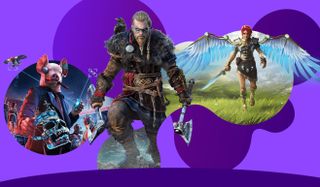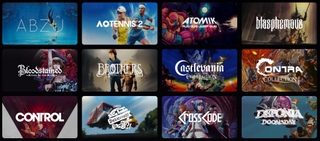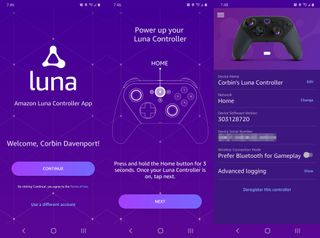Amazon Luna hands-on: a decent start for yet another cloud gaming competitor
Amazon Luna is easy to use and works pretty well, but compatibility and game selection needs more work.

It wasn’t too long ago that cloud gaming services from Google, Microsoft, and Nvidia were still experimental. Google Stadia is now around a year old, Xbox Game Streaming just left beta in September, and Nvidia GeForce Now is, well, hanging in there. If those aren’t enough for you, there will soon be yet another option for streaming games: Amazon Luna.
Amazon is uniquely positioned to create a successful streaming service. The company's servers already power a decent chunk of the internet, so building out infrastructure isn’t a problem. Amazon also owns Twitch, where most people go to watch people play games, especially after the closure of Mixer. There’s certainly potential for a compelling cloud gaming service, if Amazon plays its cards right.
I've been playing on Amazon Luna for a week, and I'm definitely impressed with some parts of the service. It works better than I expected, and already has a few high-profile games. However, Luna still struggles with the network latency that comes with all streaming services, and compatibility is mixed at the moment.
The basics
It's still early days for cloud gaming, so companies haven't quite figured out which payment scheme works best (that is to say, which scheme will make them money while being tolerated by customers and game publishers). Google Stadia charges for individual games, though paying for a Pro subscription gives you access to 4K streaming, some free games, and reduced game prices. GeForce Now lets you play the games you already bought on Steam and other services, though some publishers have blocked their games from working. Xbox Game Streaming gives you a Netflix-style catalog of games for a monthly fee, which is also the approach Amazon is going with.
Luna's game library is divided into channels, with each channel having its own monthly fee. The core channel is Luna+, which costs $6/mo and (currently) includes games like Control, GRID, Metro: Exodus, Yooka-Laylee, and Sonic Mania Plus. The only other channel right now is Ubisoft+, which costs $14.99/mo. One thing to note about the Ubisoft package is that you're getting a regular Ubisoft+ subscription and then linking it to Luna, which means you can also download the included games and run them locally if you want. Assassin's Creed Valhalla, Watch Dogs, Far Cry 5, Far Cry New Dawn, The Division, and other games are available through the Ubisoft package.
The basic Luna+ subscription already has a nice mix of big and small games, and so long as Amazon continues to add more, I don’t think $6/mo is a bad price. The Ubisoft+ channel isn’t as good of a value, but it's nice that you're not just getting Luna versions of the games. Google Stadia will also soon support Ubisoft+.

My main concern here is whether or not Amazon will be able to keep games in the subscription, or if titles will cycle in and out (possibly before you finish them), similar to what already occurs with third-party content on Netflix and similar services. Microsoft is side-stepping this issue by purchasing many publishers and game studios, but Amazon doesn’t have any established developers or publishers under its own umbrella. The company has owned a game studio since 2012, but that division has yet to release anything besides mobile games. Breakaway and Crucible were both cancelled, and New World won’t arrive until next year.
The biggest gaming news, reviews and hardware deals
Keep up to date with the most important stories and the best deals, as picked by the PC Gamer team.
The controller
Amazon has developed its own controller for Luna, which functions just like the gamepad for Google Stadia. While you can connect to it over Bluetooth or USB, where it functions like a regular controller, it’s primarily designed for Wi-Fi use. This removes some latency, since your presses don’t have to pass through a PC/phone on their way to Amazon’s servers. It also makes cross-device gameplay much more convenient—I can play a game on my desktop, then move to my TV without re-pairing the controller. Interestingly, the initial setup process is done through an Android or iOS app.

The controller is very similar to the Nintendo Switch Pro Controller, down to the two-tone look and button layout. There are only so many ways you can design a controller, but there was probably room for unique features besides simply Wi-Fi compatibility. The gamepad is powered by AA batteries, which feels slightly dated for a controller designed for next-generation gameplay.
The batteries give the Luna controller a solid weight, and the face buttons feel nice enough. Like most other wireless controllers, there's also a 3.5mm jack for easy headphones use. However, the triggers and D-Pad feel extremely mushy, and the solid ridges around the joysticks don’t feel great after extended use. Amazon definitely has a ways to go before it can compete with Sony, Microsoft, or Nintendo, but at least you can use your own gamepads with Luna. If you’re on a desktop computer, you also have the keyboard and mouse as an option, as long as the game supports that.
Playing games
Amazon Luna currently has a dedicated client application for Windows, Mac, and Fire TV. You can also play in the browser, but only on Chrome, and only on Windows and Mac. The lack of support for Linux and other browsers is definitely bizarre—even browsers based on Chrome, like Opera and the new Microsoft Edge, are blocked from playing. You also can’t play on a Chromebook or any Android devices, though an app for the latter platform is in the works. If you’re on an iPhone or iPad, Luna works through the Safari browser, since Apple has effectively blocked cloud streaming services from coming to the App Store.
The convenience of being able to start a game at any time on any (supported) device is fantastic, especially in this age of rapidly-increasing download sizes and constant patches. I ended up playing games in Luna that I never would have been interested in otherwise, not just because they had no added cost, but also because I could start playing in mere seconds. However, there is still the ultimate problem with all cloud gaming services: latency.
The first game I tried was Yooka-Laylee, and it felt great to play, even if the graphical quality was a bit of a downgrade from what I’m used to on my PC with a GTX 1080. Latency wasn’t too noticeable in that game, but it became obvious when I tried first-person shooters like Metro Exodus and Hard Reset Redux. The lag doesn’t make those games unplayable, but it does take some getting used to. I played Luna over 5GHz Wi-Fi on an Eero Pro 6 mesh network, with a ~100 MB/s download connection from Comcast, which is probably a better setup than a lot of potential customers will use.
Graphical quality was also mixed. Some games are gorgeous, like Sonic Mania and Redout, but more graphically-demanding games like Metro Exodus looked like they were running on a mid-range PC. Amazon told The Verge that Luna runs on servers with Intel Cascade Lake processors and Nvidia T4 graphics cards (which has the same Turing architecture as the RTX 2080 and 2080 Ti). That should give Luna more than enough hardware to work with, but it’s possible Amazon is sharing resources across multiple players.
No matter what game I played, I was surprised by how smooth and uncompressed the video feed was. If it weren't for the latency, I wouldn’t have been able to tell games were being streamed.
Luna is still in its infancy, and the pricing scheme could very well change before the service moves out of private beta, so it's a bit difficult to draw conclusions. I will say that Luna impressed me with its video quality, and the game selection is off to a decent start. The official controller isn’t the nicest gamepad I've ever felt, but it functions well, and helps position Luna as a simpler way to enjoy modern games wherever you are.
My greatest frustration with Luna right now is the limited compatibility. One of the main selling points for cloud gaming is that you can play from any device with a stable internet connection, but Luna lacks support for Android, browsers that aren’t Chrome (with the exception of Safari on iOS), and Linux/Chrome OS. The latency also makes for a slightly worse experience than local gaming, at least for now, and that's a problem with all cloud streaming services.
If Amazon can get enough publishers on board, Luna could end up as one of the best options for cloud gaming. That’s a big "if," though.
Corbin is a tech journalist, software developer, and longtime PC Gamer freelance writer, currently based in North Carolina. He now focuses on the world of Android as a full-time writer at XDA-Developers. He plays a lot of Planet Coaster and Fallout and hosts a podcast all about forgotten stories from tech history.
Most Popular

